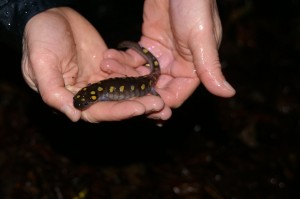Amphibians Are On the Move
give us a brake!
By MacKenzie Hall, CWF Private Lands Biologist
Over the past two weeks in New Jersey, the hills have awakened! This is the time of year when a quiet resurgence of frogs, salamanders, and toads takes place as the ground finally thaws, releasing them from their subterranean slumbers. They’ve spent nearly half a year in hibernation, and the amphibians are anxious to begin the serious business of breeding!

The earliest amphibians to head above ground are the ones that breed in temporary springtime (vernal) pools. In north Jersey these include the spotted salamander, jefferson salamander, wood frog, and the endangered blue-spotted salamander. The females emerge full of eggs…as many as 2,000 per frog and around 200 per salamander…and a lot is riding on those eggs. They are the next generation. They are our algae- and insect-eaters. They are food for other animals like garter snakes, thrushes, and bears; members of the web of life.
Helping Frogs and Salamaders Cross the Road
In areas where roads divide the woods from the water, traffic can take a huge toll on these amphibians every year. We’re doing what we can to identify amphibian road-crossing “hot spots” and to help our small, slow, slimy friends make it safely to their destinations.

Across most of NJ, the 2010 amphibian migration began on Friday, March 12th, with the first post-snowmelt rain storm of the season. The nor’easter came in early on Friday and
pummelled us with chilly rain until Monday the 15th…while we humans were holed up in our houses, those frogs & salamanders were celebrating the weather they’d been waiting for.
At one high-density crossing site in northern Warren County, we worked in teams of 5-10 people throughout Friday night to usher amphibians across the road and record what we saw (this project has been active since 2002, when the Conserve Wildlife Foundation, NJ’s Endangered and Nongame Species Program, and NJ Audubon Society partnered to create the volunteer-based effort). Over the course of 9 hours, we tallied more than 1,800 amphibians! The procession included 405 spotted salamanders, 644 wood frogs, and 742 spring peepers, with a few other species in the mix. A total of 59 vehicles passed through during that time; by reasonable estimate as many as a quarter or more of those road-crossing amphibians might not have made it without our help.

Ten of us braved the whipping storm on Saturday, March 13th, to again chaperone amphibians across the road. We stayed for a few hours (about 7:00-10:00 pm, to cover peak traffic time) and counted nearly 400 more amphibians. The vast majority of them were spring peepers, cute little tree frogs only an inch or so long. Despite the storm – with flood warnings and 40 mph wind gusts – people were still on the roads, and 27 vehicles traveled through our corridor during the 3-hour rescue survey.
After the storm finally passed, we sun-loving people got a sweeeeeeet reprieve with 6 days of bright skies and basking-quality temperatures in the 60s & 70s F. I just didn’t even know what to do with myself, I was so excited (…shorts? flip flops? laying in the grass? happiness overload!!!). The point is, whatever snow had been left in far northern NJ, and whatever ground was still frozen in the hills, wasn’t anymore.
Volunteers Count Our slimy friends
So as the next rain storm rolled in on Monday, March 22nd, another round of amphibians were ready to move. Our “drive-around” survey volunteers in Sussex, Passaic, and northern Warren & Morris Counties all reported big amphibian migrations in their areas and collected data that will help us identify the spots that warrant protection – whether in the form of rescue surveys, road closures, or an attempt at installing amphibian culverts. At our Warren County rescue site, one hardy & heroic volunteer offered to check things out around dark, and ended up staying until 1:30 in the morning when he found that amphibians were again moving in mass (you’re awesome, George!!). He tallied around 600 more amphibians, including 154 spotted salamanders, 56 American toads, countless peepers, a handful of four-toed salamanders, and even a brown snake! All of the 67 wood frogs he saw were moving away from the wetlands – their breeding and egg-laying were complete.

Amphibians will continue to be present on the wet roads all spring and summer. You can help keep them safe by limiting your driving on rainy nights and by keeping a watchful eye when you are on the road in those “froggy” conditions.
If you know of a spot where amphibians cross the road in large numbers, or if you’d like to volunteer for our project next year, please email MacKenzie Hall.
Discover more from Conserve Wildlife Foundation of NJ
Subscribe to get the latest posts sent to your email.
Leave a Comment
Great story. I will “brake” for salamanders in the future.
Comments are closed.